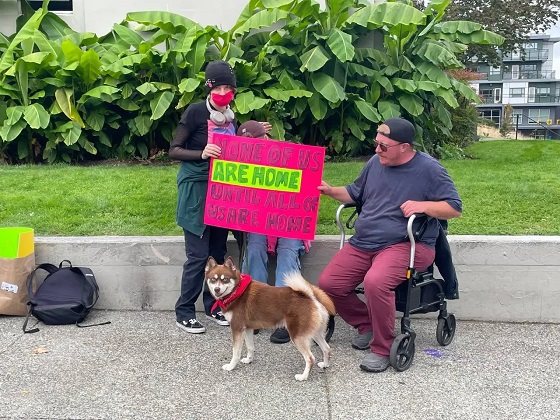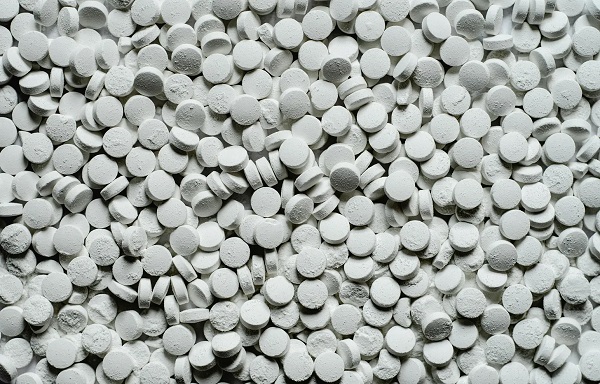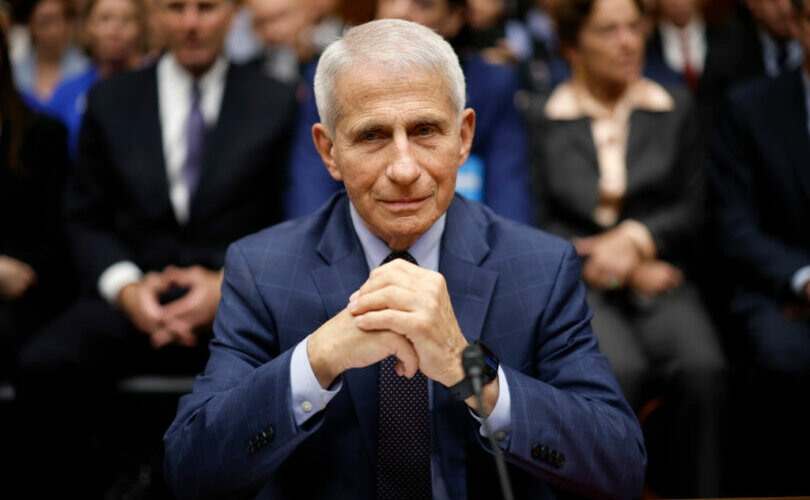Addictions
A city divided: Homelessness and drug crisis fuel tensions in Nanaimo


By Alexandra Keeler
Nanaimo, a city of approximately 100,000 situated on the eastern coast of Vancouver Island, has become a focal point in B.C.’s drug crisis. Already this year, the city has lost 68 residents to drug-related deaths.
This summer, the Nanaimo Area Public Safety Association urged city residents to come forward with information about assaults on the city’s homeless population.
The volunteer-led residents’ association was investigating claims that motorists were throwing objects at people experiencing homelessness, according to association director Collen Middleton.
“It’s not that I don’t want to believe that it’s happening — because I believe it. But there’s no evidence,” Middleton said. “It’s most likely the outreach workers, other homeless individuals or people in the street drug community with access to vehicles, like drug runners.”
These alleged assaults on homeless individuals — and the controversy surrounding them — are reflective of a broader crisis in the B.C. community.
Nanaimo, a city of approximately 100,000 situated on the eastern coast of Vancouver Island, has become a focal point in B.C.’s drug crisis. Already this year, the city has lost 68 residents to drug-related deaths. That represents five per cent of all opioid deaths in the province, despite the city being home to just two per cent of its population.
The city’s drug issues are exacerbated by a deepening housing crisis, which is the result of a shortage of shelter beds, growing homeless population and closure of support services — all of which are fueling tensions in the community.
‘Speak up’
Middleton, who moved with his family to South Nanaimo from Calgary in July 2021, says he was shocked by all the issues he saw in his neighbourhood. “Within a month we had somebody overdose and die on the other side of our garage,” he said.
Middleton found drug paraphernalia — such as needles and dime bags with drug residue — in his kids’ play area in their own backyard.
A break-in — where $5,000 worth of items were stolen from his garage — finally prompted Middleton to take action. He joined the local Facebook group Thieving Nanaimo, which has 25,000 members, and the board of the Nanaimo Area Public Safety Association.
In February, the association published a 52-page report detailing various incidents in the community, including theft, fires and property damage.
These incidents include regular break-ins and thefts at downtown businesses such as Fitz Ave Lingerie & Accessories Boutique, Red Shelf Decor and Fascinating Rhythm.
Fitz Ave Lingerie eventually installed 15 cameras and an alarm system that immediately notifies police of new incidents. It also keeps Naloxone kits on site to address drug use and overdoses in the store’s fitting rooms.
In 2023, community residents also raised concerns over the operation of an unsanctioned, “peer-supervised” drug consumption site on Nicol Street, which was run by the Nanaimo Network of Drug Users. The city labeled the property a “nuisance” but imposed no penalties. The site was ultimately shut down by its operators, who blamed the community. The operators faced no consequences for the nuisance designation, says Middleton.
“If the public didn’t speak up … I think we’d be in worse shape today,” said Middleton.
Subscribe for free to get BTN’s latest news and analysis, or donate to our journalism fund.
‘Bureaucratic hoops’
Mike Raey, a Nanaimo resident who has been intermittently homeless for the past two years, says the city is “not set up to help people who actually want the help.”
Raey, who struggles with alcohol addiction, currently stays in a shelter and keeps his belongings in a friend’s nearby tent.
Access to basic amenities like food storage are crucial for people trying to recover from addiction and stay healthy, he says. He is critical of the bureaucratic “hoops” that unhoused individuals face when seeking housing assistance.
“They have all these empty buildings — utilize them,” he said. “If they’re not up to code, bring them up to code.”
But, in some respects, the city seems to be moving in the opposite direction.
In August, it closed the Social Centre at 290 Bastion Street, a drop-in site that provided food, survival gear and a safe space to the unhoused and people struggling with addiction.
A frontline harm-reduction worker in Nanaimo, whom Canadian Affairs agreed not to name given the person’s concerns it could compromise future funding arrangements, says the centre was closed due to a lack of funding and resources to properly staff and operate the centre.
“I’ve watched service after service shut down, bed after bed,” said Benjamin Quinn, a trans Nanaimo resident who struggles with mental health issues and housing precarity. “The last holdout … was the Social Centre.”
On Sept. 3, Quinn and his nieces gathered outside Nanaimo’s city hall to protest the closure of the Social Centre and other essential services.
In an interview with Canadian Affairs, Nanaimo Mayor Leonard Krog highlighted the financial constraints the city faces addressing issues of homelessness and addiction.
“Those are fundamental, essential provincial responsibilities,” Krog said. “We work pursuant to a memorandum with BC Housing,” he said, referring to the Crown corporation responsible for developing and administering subsidized housing in the province.
A January 2024 Memorandum of Understanding between the City of Nanaimo and B.C. government includes a commitment to create 100 new temporary housing spaces in the city.
On June 28, BC Housing announced that city-owned land at 1030 Old Victoria Road would become the site of a new Nanaimo Navigation Centre. This modular building will feature approximately 60 private sleeping units for homeless individuals who have successfully stayed in shelters.
The project was narrowly approved by Nanaimo City Council in a 5-4 vote. Some councillors and community residents opposed it, citing concerns about inadequate mechanisms for fostering communication and accountability between housing operators and the community.
Krog says he supports the housing-first strategy in general, but believes certain housing solutions give rise to their own problems.
“People destroy [houses] because some individuals need secure, involuntary care,” he said. “They attract drug dealers and create environments of violence, mayhem and human trafficking. They become a different kind of hellhole.”
“You need to deal with the hardest first,” he said. “They’re never going to wake up one morning and say, ‘Oh, gee, I want to go to detox and get healthy.’ It’s not going to happen.”
Both the BC NDP and BC Conservative Party, which are competing for voter support in the upcoming election, have pledged to introduce involuntary care for people with severe addiction and mental health issues, Canadian Affairs reported last week.
The Nanimo Navigation Centre is slated to open in Spring 2025, alongside 78 supportive homes at a former Travellers Lodge hotel in Nanaimo, which has been leased by the B.C. government.
In the meantime, only 15 per cent of Nanaimo’s homeless population have somewhere to sleep at night. The city currently has 76 emergency shelter beds in total, while a 2023 survey found there were at least 515 homeless individuals — a 19 per cent increase from 2020 and nearly 200 per cent increase from 2016.
Krog insists the shortage of emergency shelters cannot be resolved at the municipal level. “We are helping, and we’ve put some money in,” he said. “But we don’t collect income tax.”
This article was produced through the Breaking Needles Fellowship Program, which provided a grant to Canadian Affairs, a digital media outlet, to fund journalism exploring addiction and crime in Canada. Articles produced through the Fellowship are co-published by Break The Needle and Canadian Affairs.
Subscribe to Break The Needle. Our content is always free – but if you want to help us commission more high-quality journalism, consider getting a voluntary paid subscription.
2025 Federal Election
Poilievre to invest in recovery, cut off federal funding for opioids and defund drug dens

From Conservative Party Communications
Poilievre will Make Recovery a Reality for 50,000 Canadians
Conservative Leader Pierre Poilievre pledged he will bring the hope that our vulnerable Canadians need by expanding drug recovery programs, creating 50,000 new opportunities for Canadians seeking freedom from addiction. At the same time, he will stop federal funding for opioids, defund federal drug dens, and ensure that any remaining sites do not operate within 500 meters of schools, daycares, playgrounds, parks and seniors’ homes, and comply with strict new oversight rules that focus on pathways to treatment.
More than 50,000 people have lost their lives to fentanyl since 2015—more Canadians than died in the Second World War. Poilievre pledged to open a path to recovery while cracking down on the radical Liberal experiment with free access to illegal drugs that has made the crisis worse and brought disorder to local communities.
Specifically, Poilievre will:
- Fund treatment for 50,000 Canadians. A new Conservative government will fund treatment for 50,000 Canadians in treatment centres with a proven record of success at getting people off drugs. This includes successful models like the Bruce Oake Recovery Centre, which helps people recover and reunite with their families, communities, and culture. To ensure the best outcomes, funding will follow results. Where spaces in good treatment programs exist, we will use them, and where they need to expand, these funds will allow that.
- Ban drug dens from being located within 500 metres of schools, daycares, playgrounds, parks, and seniors’ homes and impose strict new oversight rules. Poilievre also pledged to crack down on the Liberals’ reckless experiments with free access to illegal drugs that allow provinces to operate drug sites with no oversight, while pausing any new federal exemptions until evidence justifies they support recovery. Existing federal sites will be required to operate away from residential communities and places where families and children frequent and will now also have to focus on connecting users with treatment, meet stricter regulatory standards or be shut down. He will also end the exemption for fly-by-night provincially-regulated sites.
“After the Lost Liberal Decade, Canada’s addiction crisis has spiralled out of control,” said Poilievre. “Families have been torn apart while children have to witness open drug use and walk through dangerous encampments to get to school. Canadians deserve better than the endless Liberal cycle of crime, despair, and death.”
Since the Liberals were first elected in 2015, our once-safe communities have become sordid and disordered, while more and more Canadians have been lost to the dangerous drugs the Liberals have flooded into our streets. In British Columbia, where the Liberals decriminalized dangerous drugs like fentanyl and meth, drug overdose deaths increased by 200 percent.
The Liberals also pursued a radical experiment of taxpayer-funded hard drugs, which are often diverted and resold to children and other vulnerable Canadians. The Vancouver Police Department has said that roughly half of all hydromorphone seizures were diverted from this hard drugs program, while the Waterloo Regional Police Service and Niagara Regional Police Service said that hydromorphone seizures had exploded by 1,090% and 1,577%, respectively.
Despite the death and despair that is now common on our streets, bizarrely Mark Carney told a room of Liberal supporters that 50,000 fentanyl deaths in Canada is not “a crisis.” He also hand-picked a Liberal candidate who said the Liberals “would be smart to lean into drug decriminalization” and another who said “legalizing all drugs would be good for Canada.”
Carney’s star candidate Gregor Robertson, an early advocate of decriminalization and so-called safe supply, wanted drug dens imposed on communities without any consultation or public safety considerations. During his disastrous tenure as Vancouver Mayor, overdoses increased by 600%.
Alberta has pioneered an approach that offers real hope by adopting a recovery-focused model of care, leading to a nearly 40 percent reduction in drug-poisoning deaths since 2023—three times the decrease seen in British Columbia. However, we must also end the Liberal drug policies that have worsened the crisis and harmed countless lives and families.
To fund this policy, a Conservative government will stop federal funding for opioids, defund federal drug dens, and sue the opioid manufacturers and consulting companies who created this crisis in the first place.
“Canadians deserve better than the Liberal cycle of crime, despair, and death,” said Poilievre. “We will treat addiction with compassion and accountability—not with more taxpayer-funded poison. We will turn hurt into hope by shutting down drug dens, restoring order in our communities, funding real recovery, and bringing our loved ones home drug-free.”
Addictions
There’s No Such Thing as a “Safer Supply” of Drugs

By Adam Zivo
Sweden, the U.K., and Canada all experimented with providing opioids to addicts. The results were disastrous.
[This article was originally published in City Journal, a public policy magazine and website published by the Manhattan Institute for Policy Research. We encourage our readers to subscribe to them for high-quality analysis on urban issues]
Last August, Denver’s city council passed a proclamation endorsing radical “harm reduction” strategies to address the drug crisis. Among these was “safer supply,” the idea that the government should give drug users their drug of choice, for free. Safer supply is a popular idea among drug-reform activists. But other countries have already tested this experiment and seen disastrous results, including more addiction, crime, and overdose deaths. It would be foolish to follow their example.
The safer-supply movement maintains that drug-related overdoses, infections, and deaths are driven by the unpredictability of the black market, where drugs are inconsistently dosed and often adulterated with other toxic substances. With ultra-potent opioids like fentanyl, even minor dosing errors can prove fatal. Drug contaminants, which dealers use to provide a stronger high at a lower cost, can be just as deadly and potentially disfiguring.
Because of this, harm-reduction activists sometimes argue that governments should provide a free supply of unadulterated, “safe” drugs to get users to abandon the dangerous street supply. Or they say that such drugs should be sold in a controlled manner, like alcohol or cannabis—an endorsement of partial or total drug legalization.
But “safe” is a relative term: the drugs championed by these activists include pharmaceutical-grade fentanyl, hydromorphone (an opioid as potent as heroin), and prescription meth. Though less risky than their illicit alternatives, these drugs are still profoundly dangerous.
The theory behind safer supply is not entirely unreasonable, but in every country that has tried it, implementation has led to increased suffering and addiction. In Europe, only Sweden and the U.K. have tested safer supply, both in the 1960s. The Swedish model gave more than 100 addicts nearly unlimited access through their doctors to prescriptions for morphine and amphetamines, with no expectations of supervised consumption. Recipients mostly sold their free drugs on the black market, often through a network of “satellite patients” (addicts who purchased prescribed drugs). This led to an explosion of addiction and public disorder.
Most doctors quickly abandoned the experiment, and it was shut down after just two years and several high-profile overdose deaths, including that of a 17-year-old girl. Media coverage portrayed safer supply as a generational medical scandal and noted that the British, after experiencing similar problems, also abandoned their experiment.
While the U.S. has never formally adopted a safer-supply policy, it experienced something functionally similar during the OxyContin crisis of the 2000s. At the time, access to the powerful opioid was virtually unrestricted in many parts of North America. Addicts turned to pharmacies for an easy fix and often sold or traded their extra pills for a quick buck. Unscrupulous “pill mills” handed out prescriptions like candy, flooding communities with OxyContin and similar narcotics. The result was a devastating opioid epidemic—one that rages to this day, at a cumulative cost of hundreds of thousands of American lives. Canada was similarly affected.
The OxyContin crisis explains why many experienced addiction experts were aghast when Canada greatly expanded access to safer supply in 2020, following a four-year pilot project. They worried that the mistakes of the recent past were being made all over again, and that the recently vanquished pill mills had returned under the cloak of “harm reduction.”
Subscribe for free to get BTN’s latest news and analysis – or donate to our investigative journalism fund.
Most Canadian safer-supply prescribers dispense large quantities of hydromorphone with little to no supervised consumption. Patients can receive up to 40 eight-milligram pills per day—despite the fact that just two or three are enough to cause an overdose in someone without opioid tolerance. Some prescribers also provide supplementary fentanyl, oxycodone, or stimulants.
Unfortunately, many safer-supply patients sell or trade a significant portion of these drugs—primarily hydromorphone—in order to purchase more potent illicit substances, such as street fentanyl.
The problems with safer supply entered Canada’s consciousness in mid-2023, through an investigative report I wrote for the National Post. I interviewed 14 addiction physicians from across the country, who testified that safer-supply diversion is ubiquitous; that the street price of hydromorphone collapsed by up to 95 percent in communities where safer supply is available; that youth are consuming and becoming addicted to diverted safer-supply drugs; and that organized crime traffics these drugs.
Facing pushback, I interviewed former drug users, who estimated that roughly 80 percent of the safer-supply drugs flowing through their social circles was getting diverted. I documented dozens of examples of safer-supply trafficking online, representing tens of thousands of pills. I spoke with youth who had developed addictions from diverted safer supply and adults who had purchased thousands of such pills.
After months of public queries, the police department of London, Ontario—where safer supply was first piloted—revealed last summer that annual hydromorphone seizures rose over 3,000 percent between 2019 and 2023. The department later held a press conference warning that gangs clearly traffic safer supply. The police departments of two nearby midsize cities also saw their post-2019 hydromorphone seizures increase more than 1,000 percent.
The Canadian government quietly dropped its support for safer supply last year, cutting funding for many of its pilot programs. The province of British Columbia (the nexus of the harm-reduction movement) finally pulled back support last month, after a leaked presentation confirmed that safer-supply drugs are getting sold internationally and that the government is investigating 60 pharmacies for paying kickbacks to safer-supply patients. For now, all safer-supply drugs dispensed within the province must be consumed under supervision.
Harm-reduction activists have insisted that no hard evidence exists of widespread diversion of safer-supply drugs, but this is only because they refuse to study the issue. Most “studies” supporting safer supply are produced by ideologically driven activist-scholars, who tend to interview a small number of program enrollees. These activists also reject attempts to track diversion as “stigmatizing.”
The experiences of Sweden, the United Kingdom, and Canada offer a clear warning: safer supply is a reliably harmful policy. The outcomes speak for themselves—rising addiction, diversion, and little evidence of long-term benefit.
As the debate unfolds in the United States, policymakers would do well to learn from these failures. Americans should not be made to endure the consequences of a policy already discredited abroad simply because progressive leaders choose to ignore the record. The question now is whether we will repeat others’ mistakes—or chart a more responsible course.
Our content is always free –
but if you want to help us commission more high-quality journalism,
consider getting a voluntary paid subscription.
-

 2025 Federal Election1 day ago
2025 Federal Election1 day agoRCMP memo warns of Chinese interference on Canadian university campuses to affect election
-

 2025 Federal Election1 day ago
2025 Federal Election1 day agoResearchers Link China’s Intelligence and Elite Influence Arms to B.C. Government, Liberal Party, and Trudeau-Appointed Senator
-

 MAiD2 days ago
MAiD2 days agoDisability rights panel calls out Canada, US states pushing euthanasia on sick patients
-

 Justice2 days ago
Justice2 days agoCanadian government sued for forcing women to share spaces with ‘transgender’ male prisoners
-

 Alberta2 days ago
Alberta2 days agoAlberta takes big step towards shorter wait times and higher quality health care
-

 Energy2 days ago
Energy2 days agoTrump signs four executive orders promoting coal industry
-

 COVID-1922 hours ago
COVID-1922 hours agoFauci, top COVID officials have criminal referral requests filed against them in 7 states
-

 Business1 day ago
Business1 day agoScott Bessent Says Trump’s Goal Was Always To Get Trading Partners To Table After Major Pause Announcement










